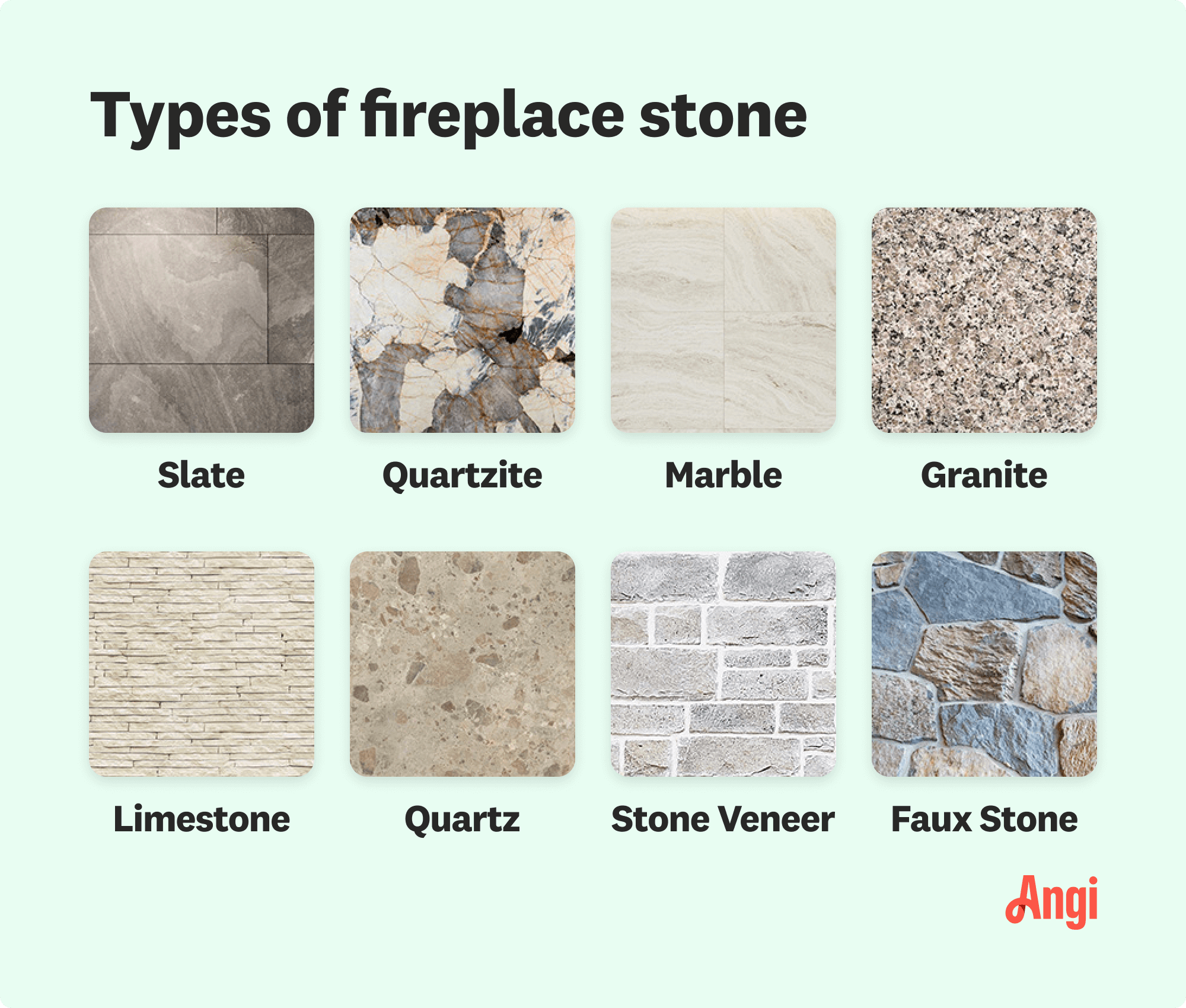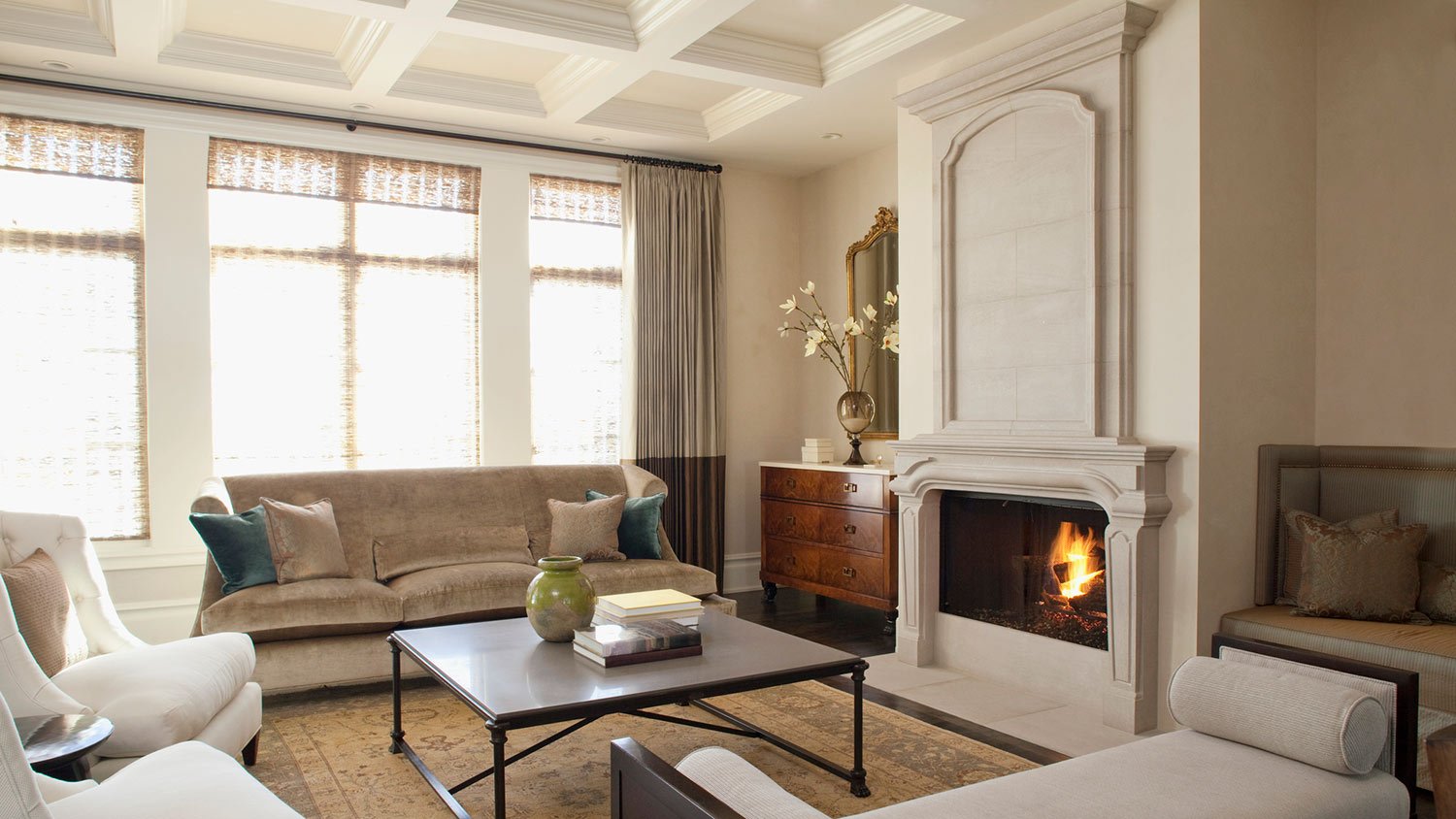
This guide shares information about the cost to remove a gas fireplace, including the average price to additionally remove the breast, stack, and chimney flue as well as which experts will be needed to complete the project.
Learn your stacked limestone from your marble slabs


Hire a fireplace installation pro to discuss options for stone fixtures, as they'll be able to pick the perfect stone type for your fireplace.
Limestone, faux stones, and stone veneers are the best picks for those on a budget.
More expensive options include slate, quartzite, and marble, though all three are gorgeous.
Durability is a concern, so go with granite or slate for an outdoor fireplace.
Stone veneer and limestone will likely need to be resealed every few years.
From a sleek, minimalist look to a rustic, cabin-in-the-woods vibe, stone is an extremely versatile material for your fireplace. There are several types of stone for a fireplace: slate, quartzite, marble, granite, limestone, quartz, stone veneer, and faux stone. With so many options, it’s easy to find one that fits both your home’s aesthetic and budget. Explore the different types of stone for fireplaces and find which one will work best for your fireplace.

Slate is a good option for fireplace surrounds, combining a modern look with a warm, cozy ambiance. This material is a metamorphic rock in thin but hefty sheets, often in black or gray tones, but you can also find slate in green, blue, or even red tones. No matter what color you choose, slate comes with natural variations that make every project unique.
Because slate is a high-end and heavy material, installation costs are higher compared to other types of fireplace stone, like limestone. Also, it easily scratches, so take extra care when cleaning around the fireplace to avoid leaving behind scuffs. Because it can be vulnerable to high heat, reserve slate for the surround of a gas fireplace or an electric unit rather than wood-burning fireplaces.
| Pros | Cons |
|---|---|
| Low-maintenance | Higher cost |
| Unique texture | Heavy |
| Hides dirt and stains | Prone to scratches |
Best for: Gas or electric fireplaces

Quartzite is a natural stone that offers a look similar to marble or granite. While quartzite isn’t entirely non-porous like quartz, veneer, or other human-made stones, it isn’t as porous as marble or limestone. This means you can skip sealing the stone, cutting back on some of the fireplace maintenance you need to handle.
Quartzite is durable against many common problems, including heat, scratches, and dents, but you’ll have to pay a higher cost, around $60 to $200 per square foot. You’ll also need to use gentle cleansers on quartzite because it’s vulnerable to etching.
| Pros | Cons |
|---|---|
| Low-maintenance | High cost |
| High durability | Prone to etching |
| Less porous | Difficult to install |
Best for: All fireplace types

If you’re dreaming of a glamorous living space where the fireplace is the focal point, you can’t go wrong with marble. This show-stopping stone features patterns of thick to thin veining and comes in a wide variety of colors. Because the material is vulnerable to moisture and acidity, sealing it will preserve the stone for longer. Marble is one of the most expensive types of stone for a fireplace, so be sure to budget accordingly if it’s the stone you want for your home.
Marble is heavy, so you’ll need to make sure your foundation is properly prepped to handle the larger load. You should also leave marble fireplace installation—and all fireplace installation, really— to a local fireplace installer.
| Pros | Cons |
|---|---|
| Luxury look | Higher cost |
| Highly durable | Porous |
| Many design choices | Difficult installation |
Best for: All fireplace types and those who want a high-end, luxury look
Granite is an igneous rock that comes in a wide range of colors and patterns, and you can even find granite options that mimic marble for a lower cost. While it may not cost quite as much as marble, granite is a high-end material that still costs more than other options on this list, like limestone and stone veneer. Like other natural stones, granite benefits from sealant to better protect it against moisture and discoloration, but otherwise, you can enjoy the scratch- and heat-resistant benefits of this extremely durable stone.
| Pros | Cons |
|---|---|
| Variety of designs | Porous |
| Extremely durable | Prone to discoloration |
| Stain-resistant | Higher cost |
Best for: Gas or wood-burning fireplaces

Limestone is a sedimentary rock that comes in soft, neutral beige tones. This allows a stacked stone fireplace made of limestone to fit into many different decor styles, from traditional and rustic to minimalist and contemporary. This material is durable, so you don’t have to worry about accidentally scratching or denting the stone when maintaining your fireplace.
It’s also easy to clean, but limestone can be very absorbent. To better protect against erosion and stains, apply a sealant to your limestone fireplace.
| Pros | Cons |
|---|---|
| Lower cost | Absorbent |
| Low-maintenance | Limited color options |
| High durability | Needs sealant |
Best for: All fireplace types and those on a budget
Not to be confused with quartzite (which is a natural stone), quartz fireplaces are made of crushed quartz rock, a type of igneous rock, and resins. Because it isn’t made entirely with natural stone, quartz is non-porous, so there’s no need to seal the fireplace. This material holds up well against moisture, acidity, and heat, although quartz isn’t as heat-resistant as other stones, like limestone and granite.
Because manufacturers can add pigment to quartz, it can be made into a wide range of colors to suit any style. However, if you want to add a more natural element to your space, quartz doesn’t offer quite the same look as 100% natural stone—although it may be a good compromise between natural and faux stone.
| Pros | Cons |
|---|---|
| Non-porous | Lower heat resistance |
| Low-maintenance | Prone to discoloration |
| Wide design variety | Less sustainable |
Best for: Gas and electric fireplaces

Stone veneer is made with thin pieces of natural stone or concrete. The veneer makes the material not only lightweight but also easier to install, especially because the pieces are manufactured in uniform sizes. Depending on the material, stone veneer can be durable against scratches, dents, stains, and other damage.
They aren’t invincible, though. Stone veneer needs to be sealed well or moisture can become trapped between and behind the panels.
| Pros | Cons |
|---|---|
| Lightweight | Vulnerable to moisture |
| Easy to install | Requires sealant |
| Uniform design | Less natural look |
Best for: All fireplace types
If you want the look of natural stone for less, consider faux stones. These stones are made from materials like cement and plastic, so they cost less but offer plenty of durability for a fireplace surround. Compared to natural stone, these materials are easier to keep clean and maintain, and you can skip the sealant. Plus, they can be made to look like a wide range of different natural stones.
Keep in mind that the high heat from a fireplace can wear down faux stones over time, leading to discoloration or even cracking in plastic-based faux stones.
| Pros | Cons |
|---|---|
| Lower cost | Less natural look |
| Wide design variety | Prone to discoloration |
| Easy to clean | Prone to cracking |
Best for: Gas or electric fireplaces
It can be hard to narrow down types of stone since there are so many beautiful options. Here are tips for selecting the best stone for your fireplace:
Decide on a budget and consider limestone or stone veneer for budget-friendly projects and granite or marble for high-end designs.
Look at fireplace styles and colors to determine what resonates with you and whether you want a bold, contrasting, or subdued aesthetic.
Bring stone samples home to assess them in the room’s lighting and colors.
Consider the durability and maintenance of the stone. With stone veneer and limestone, you’ll need to reseal it every few years. For an outside fireplace, stick with granite or slate.
Coordinate the stone with the style and architecture of your home for a cohesive look.
Get ideas and quotes from at least three local fireplace installers.
Perfect job was done ! I would recommend this company to my friends , relatives,anybody! And they are very reasonable! . This is the first time I had a quote I could afford. Thank you Judith Morees and company.
Jose come to do the job in a timely manner. He completed the project in one trip. Also, he removed all the debris.
They did a great job of installing our fence. They took down the old and put up all new fencing in 3 days. Great work and very professional. Even was able to work with us and our dogs. Would hire again for other projects.
Very happy with the work and professionalism from Ideal Siding. He diagnosed the problem and was able to come by on the same day to repair backside siding.They also fixed a few smaller issues with the roof that they noticed at the same time. Highly recommend them.
Very professional and very reasonably priced. We will definitely use them in the future!
Punctual and thorough. I will suggest them to my friends.
Did a fantastic job in a timely manner and didnâ t charge me more than the job was worth. Highly recommend.
Awesome family owned business that went above and beyond. Thomas gave us an excellent quote for the job they did and we couldnâ t be happier with the results they gave us. Definitely recommend and will use again in the future.
The technician John was very professional and engaging as he fixed my issue. He explained what he was doing which I really liked.
I absolutely loved the outcome. Thanks so much for getting the job done in a swift and timely manner
From average costs to expert advice, get all the answers you need to get your job done.

This guide shares information about the cost to remove a gas fireplace, including the average price to additionally remove the breast, stack, and chimney flue as well as which experts will be needed to complete the project.

An outdoor fireplace can easily cost over $3,000 if you aren’t careful with your budget. Learn what factors contribute to the overall cost of this luxury project.

Before installing a gas fireplace insert, it’s important to understand the various cost factors. Here’s how much an average gas fireplace insert costs.

Fireplace maintenance is the best way to ensure your fireplace is working safely and efficiently. By cleaning it and hiring a professional to check it regularly, you can significantly reduce the risk of safety threats.

Gas fireplaces may emit a sulfuric or burning plastic smell from time to time. Learn why your gas fireplace smells like gas or plastic and what to do next.

Gaps and other faults in your chimney flashing sealant can leave your home vulnerable to leaks. Learn how to seal chimney flashing with this guide.